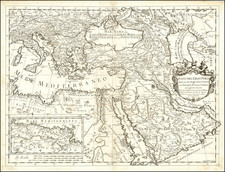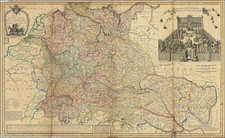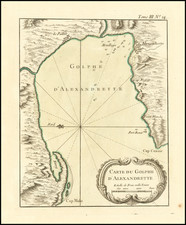Wall Map of the Ottoman Empire at the dawn of the 19th Century
Fine example of Aaron Arrowsmith’s large and detailed map of the Ottoman Empire and the Black Sea, with Cyprus, Crete and the Greek Islands in the Mediterranean Sea, Albania, Bosnia and Herzogovinia.
The map illustrates the Ottoman Empire at the tail end of its domination of Greece and the Balkans. Within 30 years, Greece would gain its independence.
As noted by Rumsey:
Arrowsmith's large and detailed map of the Ottoman Empire and the Black Sea. By the beginning of the nineteenth century the Ottoman Empire had fallen some way from the lofty heights of 1683, when it had threatened the gates of Vienna. The Russo-Turkish wars of the eighteenth century most notably that of 1768-1774 weakened the Empire considerably, and by the time of the present map's publication many of the Great European powers believed her break-up to be imminent. The ramifications of the Empire's gradual decline became know as the Eastern Question; with Britain, Austria, France, and Russia increasingly using the Empire as a pawn in their diplomatic games.
At the time of the production of the map during the Napoleonic War - Britain was increasingly concerned by both Russian and French involvement in Ottoman affairs. She feared not only Russian designs on Constantinople and her wish for a Mediterranean port; but also that control by either power of the Eastern Mediterranean would lead to British interests - most notably in India being severely compromised."
The Arrowsmiths were a cartographic dynasty which operated from the late-eighteenth century to the mid-nineteenth. The family business was founded by Aaron Arrowsmith (1750-1823), who was renowned for carefully prepared and meticulously updated maps, globes, and charts. He created many maps that covered multiple sheets and which were massive in total size. His spare yet exacting style was recognized around the world and mapmakers from other countries, especially the young country of the United States, sought his maps and charts as exemplars for their own work.
Aaron Arrowsmith was born in County Durham in 1750. He came to London for work around 1770, where he found employment as a surveyor for the city’s mapmakers. By 1790, he had set up his own shop which specialized in general charts. Arrowsmith had five premises in his career, most of which were located on or near Soho Square, a neighborhood the led him to rub shoulders with the likes of Joseph Banks, the naturalist, and Matthew Flinders, the hydrographer.
Through his business ties and employment at the Hydrographic Office, Arrowsmith made other important relationships with Alexander Dalrymple, the Hudson’s Bay Company, and others entities. In 1810 he became Hydrographer to the Prince of Wales and, in 1820, Hydrographer to the King.
Aaron Arrowsmith died in 1823, whereby the business and title of Hydrographer to the King passed to his sons, Aaron and Samuel, and, later, his nephew, John. Aaron Jr. (1802-1854) was a founder member of the Royal Geographical Society (RGS) and left the family business in 1832; instead, he enrolled at Oxford to study to become a minister. Samuel (1805-1839) joined Aaron as a partner in the business and they traded together until Aaron left for the ministry. Samuel died at age 34 in 1839; his brother presided over his funeral. The remaining stock and copper plates were bought at auction by John Arrowsmith, their cousin.
John (1790-1873) operated his own independent business after his uncle, Aaron Arrowsmith Sr., died. After 1839, John moved into the Soho premises of his uncle and cousins. John enjoyed considerable recognition in the geography and exploration community. Like Aaron Jr., John was a founder member of the RGS and would serve as its unofficial cartographer for 43 years. Several geographical features in Australia and Canada are named after him. He carried the title Hydrographer to Queen Victoria. He died in 1873 and the majority of his stock was eventually bought by Edward Stanford, who co-founded Stanford’s map shop, which is still open in Covent Garden, London today.













![Carte de la Hongrie et des Pays qui en dependoient autresois dressée sur un grand nombre de memoire. . . 1703 [Map of Hungary and the countries that used to depend on it, previously drawn from a large number of records... 1703.]](https://storage.googleapis.com/raremaps/img/small/93871.jpg)


![Insularum Aliquot Maris Mediterranei Descriptio [Sicily, Malta, Sardinia, Corfu, Elba and Zerbia] (1570A First State)](https://storage.googleapis.com/raremaps/img/small/87925.jpg)